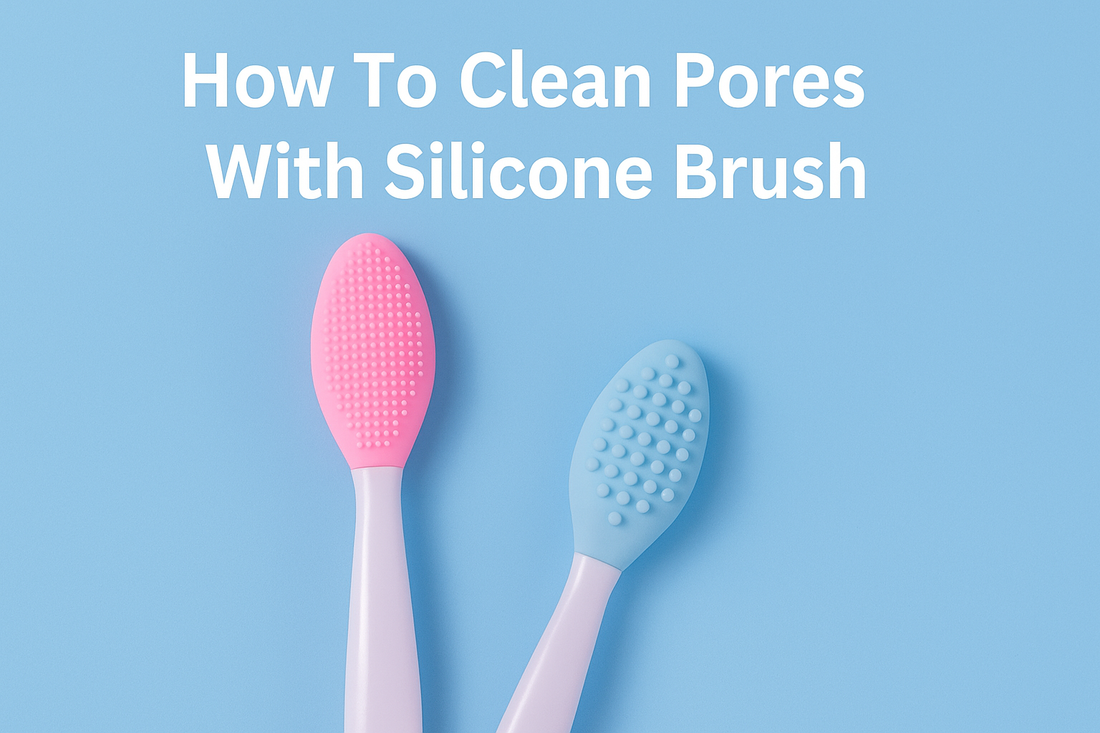
How to Clean Pores with a Silicone Brush
Share
Clogged pores are one of the most common skincare struggles — they trap oil, dirt, and dead skin cells, leading to blackheads, whiteheads, and dull skin.
If your regular face wash isn’t giving you that fresh, smooth finish, a silicone facial cleansing brush could be your new best friend.
In this expert guide, we’ll explain how to clean pores with a silicone brush, the science behind it, and how to choose and use it safely for your unique skin type.
🪞 What Is a Silicone Facial Cleansing Brush?
A silicone facial brush is a soft, flexible skincare device designed to gently exfoliate and deep-clean pores.
Unlike traditional bristle brushes, silicone models use soft, antibacterial bristles that glide smoothly on the skin — perfect for sensitive and acne-prone complexions.
Core Features:
-
Soft silicone bristles: gentle yet effective on the skin.
-
Antibacterial material: resists bacteria buildup.
-
Manual or electric: available in handheld and rechargeable versions.
- Waterproof and reusable: eco-friendly and cost-effective.
💧 How a Silicone Brush Works on Your Skin
Silicone cleansing brushes help perform deep pore cleansing by using vibration or manual pressure to loosen impurities.
Here’s what happens during use:
-
Removes dirt and oil from deep within pores.
-
Exfoliates dead skin cells, revealing smoother texture.
-
Improves blood circulation and skin radiance.
-
Boosts product absorption for toners, serums, and moisturizers.
💡 According to dermatologists on Healthline, gentle mechanical exfoliation (like silicone brushes) helps unclog pores without causing irritation — especially when paired with a pH-balanced facial cleanser.
🧴 Step-by-Step: How to Clean Pores with a Silicone Brush
🪞 Step 1: Remove Makeup and Prep Skin
Start by using a micellar water or oil-based cleanser to remove makeup, sunscreen, and surface impurities.
💧 Step 2: Apply Cleanser
Use a non-comedogenic, foaming, or gel cleanser suited for your skin type (for example, hyaluronic acid cleanser for dry skin or salicylic acid cleanser for oily skin).
🌀 Step 3: Gently Massage with the Silicone Brush
-
Dampen your face and the brush.
-
Move the brush in circular motions around your face — focusing on nose, chin, and forehead where pores are larger.
-
Continue for 60–90 seconds.
💦 Step 4: Rinse and Pat Dry
Rinse your face with lukewarm water, pat dry with a clean towel — avoid rubbing.
🌸 Step 5: Follow with Skincare
Apply toner, serum, and moisturizer to seal in hydration and maintain a healthy skin microbiome.
🌿 Best Practices for Different Skin Types
|
Skin Type |
Recommended Use |
Tips |
|
Oily/Acne-Prone |
1–2 times daily |
Use salicylic acid or clay cleansers |
|
Dry/Sensitive |
2–3 times weekly |
Choose soft silicone bristles; avoid harsh scrubs |
|
Combination |
Daily or alternate days |
Focus on T-zone |
|
Normal Skin |
Daily |
Pair with gentle foaming cleanser |
🩺 Dermatologist tip: Avoid pressing too hard. Let the brush glide — over-exfoliating can strip natural oils and worsen irritation.
⚖️ Silicone Brush vs Nylon Brush: Which Is Better?
|
Feature |
Silicone Brush |
Nylon Brush |
|
Bristle Texture |
Soft & flexible |
Firm & abrasive |
|
Hygiene |
Antibacterial |
Traps bacteria easily |
|
Durability |
Long-lasting |
Needs frequent replacement |
|
Skin Safety |
Gentle for sensitive skin |
Can cause irritation |
|
Eco-Friendly |
Reusable |
Often disposable |
👉 Verdict: Silicone brushes are better for daily gentle exfoliation and maintaining a balanced, clean complexion.
🧼 How Often Should You Use a Silicone Face Brush?
-
Daily for oily or combination skin.
-
2–3 times per week for dry or sensitive skin.
-
Avoid excessive use — over-cleansing can lead to dryness or barrier damage.
🔍 Tip: Always listen to your skin — tightness or redness means you’re cleansing too aggressively.
🧽 How to Clean and Maintain Your Silicone Brush
-
Rinse immediately after each use to remove residue.
-
Use mild soap or antibacterial cleanser to sanitize.
-
Air dry on a clean surface — avoid damp storage.
-
Deep clean weekly with warm water and vinegar if needed.
Keeping your brush clean prevents bacteria buildup and ensures long-term performance.
💡 Expert Tips from Dermatologists
“Silicone cleansing brushes are excellent for maintaining skin clarity — especially for acne-prone users. Just ensure gentle pressure and avoid harsh scrubs.”
— Dr. Melissa Levin, Board-Certified Dermatologist (via Allure)
-
Always patch-test if you have sensitive or reactive skin.
-
Pair with hydrating cleansers to maintain the skin barrier.
- Avoid alcohol-based cleansers that strip natural oils.
🛍️ Top-Rated Silicone Brushes for Deep Pore Cleansing
|
Product |
Key Features |
Best For |
|
Foreo Luna Mini 3 |
Ultrasonic technology, waterproof, long battery |
All skin types |
|
PMD Clean |
Sonic vibration, dual cleansing & massage modes |
Mature & dry skin |
|
Radiant Glow Silicone Pore Brush |
Gentle manual exfoliation, eco-friendly |
Daily use & beginners |
|
Innisfree Smart Cleansing Brush |
Compact, travel-friendly |
Oily skin |
⚠️ Common Mistakes to Avoid
-
Using too much pressure while brushing.
-
Skipping cleaning the brush after use.
-
Using harsh scrubs or acids simultaneously.
-
Not moisturizing afterward.
- Sharing brushes (bacteria risk).
🌟 Conclusion: Your Path to Clear, Radiant Skin
Learning how to clean pores with a silicone brush can truly transform your skincare routine.
It’s a gentle, hygienic, and effective method to achieve that smooth, glowing look — without over-scrubbing or damaging your skin barrier.
Regular use, the right technique, and consistent hygiene make all the difference.
❓ FAQs
1. What is the correct way to use a silicone facial brush?
Use gentle circular motions with a mild cleanser for about one minute. Avoid harsh scrubbing.
2. Can silicone brushes damage sensitive skin?
No, if used gently. Choose soft silicone bristles and avoid daily use if your skin feels irritated.
3. How often should I replace my silicone brush?
Unlike nylon brushes, silicone brushes can last for years if properly cleaned.
4. Can I use a silicone brush with an exfoliating cleanser?
Use either the brush or the exfoliant — not both together, to prevent over-exfoliation.
5. What cleanser should I use with a silicone brush?
Opt for non-comedogenic, pH-balanced, and gentle foaming cleansers.
6. Is it safe to use a silicone brush daily?
Yes, for most skin types — but reduce frequency if your skin becomes dry or red.
7. Can I use it with makeup remover?
Yes, especially oil-based removers before your main cleanser in a double cleansing method.
